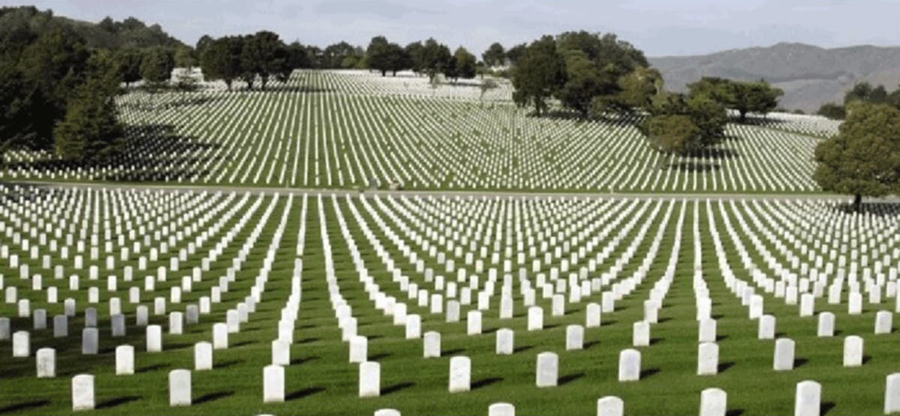
Death. It’s inevitable, it’s iconic, it’s unavoidable. It fascinates us, frightens us, and fuels our economy. And as if the grim reaper were not enough, we do his job for him.
Humans have been killing each other for a very long time, perhaps forever. The Old Testament makes this perfectly clear as it recounts brother killing brother, alongside an unending litany of treachery and murder. The archeological record of earlier civilizations – the Aztecs, the Maya, the Incas, among them – documents killing on an industrial scale, societies in which organized warfare and incalculable slaughter was carried out for religious and political purposes to support hierarchies of power. During the past five centuries, governments north, south, east, and west have killed many millions of people, all in the name of a better tomorrow.
And it’s not just people we kill. We raise and butcher animals by the billions, an industrialized spectacle of death and dismemberment placed proudly on display at the local supermarket in orderly rows of cutlets, chops, wings, bellies, loins and fillets. The Aztecs purportedly placed the torn-out hearts of their sacrificial victims on a fiery grill; we, in turn, gleefully toss marinated baby back ribs on the Weber and wipe our greasy faces with paper napkins.
Those napkins, notably, are mostly manufactured from the carcasses of slaughtered trees, which like chickens, are systematically grown and killed with unparalleled efficiency. That same ruthlessness is applied to Mother Earth herself, where mining interests, logging operators, cattle ranchers, chemical companies, and water polluters kill entire ecosystems with gross impunity, all in the name of progress.
Killing is so thoroughly embedded into our psyches it’s made its way into metaphors of common speech. We make a “killing” in the market, “kill ‘em” onstage, describe challenging tasks as “murder,” develop “killer” apps, and put problems “out of their misery.” Books, films and television present a constant fantasy parade of serial killers, murderers, homicidal husbands, bloody mortal combat, crazed flesh-eating zombies, thirsty blood-sucking vampires and human-hungry aliens from another world intent on eating people for dinner.
Is it our fear of death that keeps us enthralled with killing, some magical thinking that the sacrifice of others protects us? It was just this sort of rationale that built the towers of skulls that welcomed Cortez and his crew of Spanish soldiers into the Aztec capital in 1520. Five centuries later, in 2021, the ever-present threat of death fuels an armaments industry specialized in making killing machines, from hand-held firearms, automatic assault weapons, armor piercing ordinance, drone-fired missiles, and smart bombs to multi-megaton nuclear weapons. As much as we’d like to deny it, modern society avails itself of killing and the threat of death just as much as ancient societies employed it.
Is our killing fetish an inheritance of our primate past? Is the natural wildness of life to blame? Life does feed on death, from the tiniest amoebas to the largest Blue Whales, but generally, it appears that only humans have transformed this gritty reality into full-blown cultures. In this way, human imagination is empowered to cope with fear, a so-called rational response to uncomfortable emotion. What may once have been a protective mechanism has, however, become suicidal. In the name of a better tomorrow, we are on the verge of killing our planet, ourselves and all its inhabitants.
Here is a paradox Larry. Like everyone, I read stories and watch dramas with violence at their core, and, as you say, perhaps I am obsessed with narratives of violence. I am even a fan of military history and I become impressed with the exploits of people like U.S. Grant and Garbaldi. But I organize my own life and expect others to organize theirs to minimize the use of force. I find actual violence, when I come accross it, revolting.
I think it’s about intimacy, Bill, the intimacy of feelings. Bataille covers the connection between violence and intimacy in exploring the subject of public sacrifice. Graeber goes on to discuss “play” war, it’s development as ritual and evolution into spectator sports. The displacement of the feelings of excitement and being connected to the intimacy of violence into “play” forms (books, movies, etc.) makes exposure to real violence uncomfortable to most of us, but psychopaths experience this differently, seeking intimacy through real violence. This is, say Psychologist Sue Grand, the source of stimulus for serial killers, who seeing intimacy (control over others, and vulnerability) repeat the killing scenario over and over. So I don’t see it as a paradox, rather a psychological “adjustment”, the displacement of immature Id (in Freud’s terms) with more mature social self control. Melanie Klein would say serial killers are stuck in the Paranoid/Schizoid phase of development, the place all begin but with maturity overcome and replace with the self-introspective, historical depressive phase (as she called it).